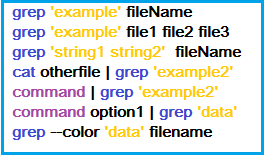
WORD - WORD consists of a sequence of non-blank characters, separated with white space. You may want to do several navigation in relation to the words, such as: Please create the following demo_text file for this example. You might feel handy if grep can show you not only the matching lines but also the lines after/before/around the match.

When doing a grep on a huge file, it may be useful to see some lines after the match. Displaying lines before/after/around the match using grep -A, -B and -C $ grep -iw "is" demo_fileĪnd this is the last line. Please note that this output does not contain the line “This Line Has All Its First Character Of The Word With Upper Case”, even though “is” is there in the “This”, as the following is looking only for the word “is” and not for “this”. The following example is the WORD grep where it is searching only for the word “is”. When you search for “is”, without any option it will show out “is”, “his”, “this” and everything which has the substring “is”. The following example is the regular grep where it is searching for “is”. Just doing out a normal search will show out all the lines. If you want to search for a word, and to avoid it to match the substrings use -w option.
#Bash grep all files in directory full
Checking for full words, not for sub-strings using grep -w

In this article let us review 15 practical examples of Linux grep command that will be very useful to both newbies and experts.įirst create the following demo_file that will be used in the examples below to demonstrate grep command. Earlier we discussed 15 practical examples for Linux find command, Linux command line history and mysqladmin command. This is part of the on-going 15 Examples series, where 15 detailed examples will be provided for a specific command or functionality. This will only return for a search of html if that exists on its own line separately.You should get a grip on the Linux grep command. -x - match only if the whole lines only.

-f - used to indicate a file you want to use which contains a regular expression.searching for html with -v will return everything without html. -h - output the line itself, without the line number or file.-n - returns the line number, but doesn't work with -l.For example, if we search for 'html', then somehtmltext would not match. When we write -rl, this means essentially -r -l, which means search recursively, and return only the file name.īelow is a list of all grep options or switches, which you can add to your query to get the results you need: When we say -r, for example, we mean 'recursive' - i.e. You can string other options together, to get different results. views -e 'html' Options for grep on Linux/Mac


 0 kommentar(er)
0 kommentar(er)
